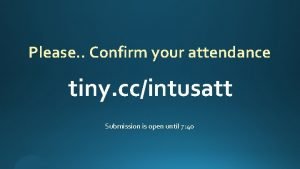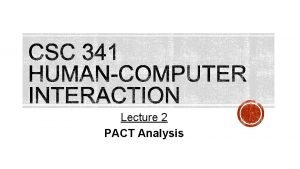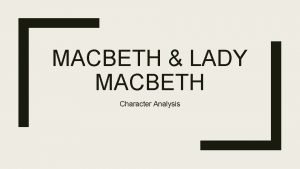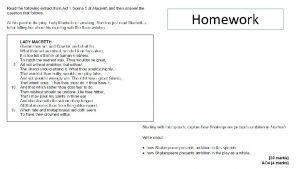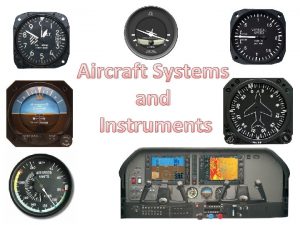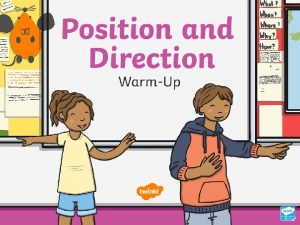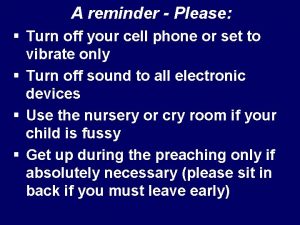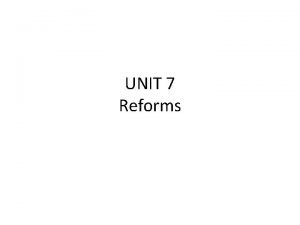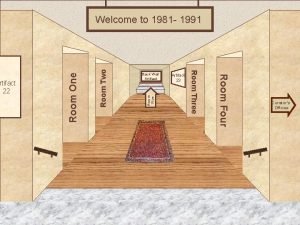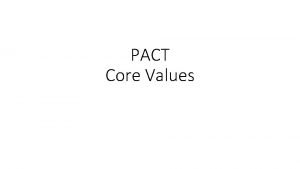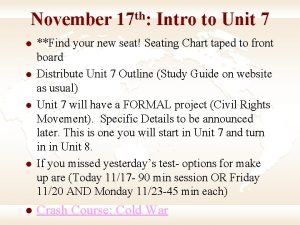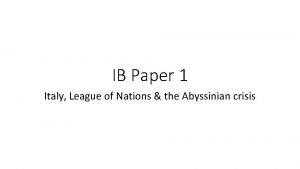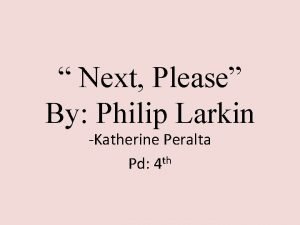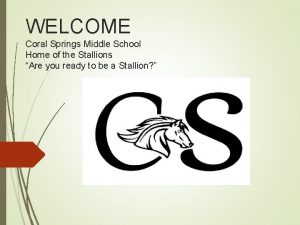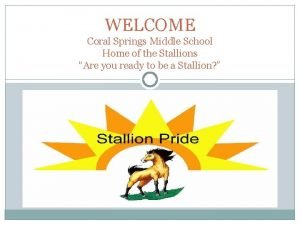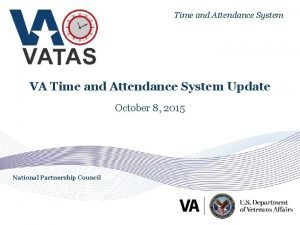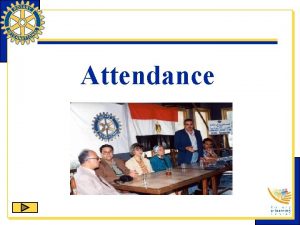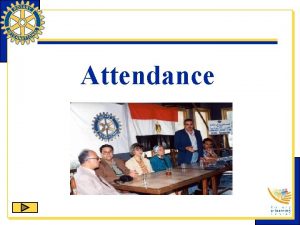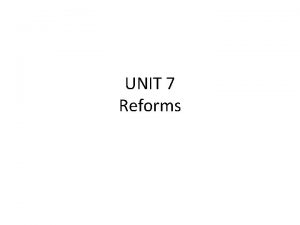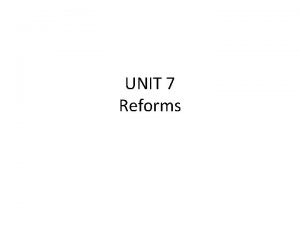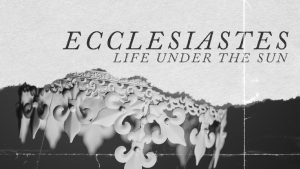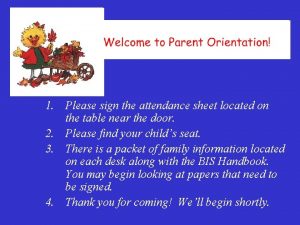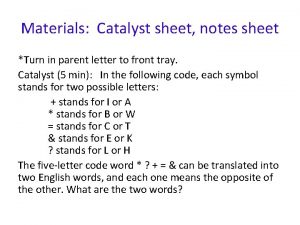Lecture 2 PACT Analysis Attendance sheet Please turn































































- Slides: 63

Lecture 2 PACT Analysis

§ Attendance sheet § Please turn in HW 1 § Course website § Project ideas § Deadline for requirements analysis Oct. 1 st.

http: //discovery. ucl. ac. uk/7150/1/7150. pdf

http: //discovery. ucl. ac. uk/7150/1/7150. pdf

§ Not considering users who used the PC § Systems developed by programmers who used computers for everyday work § Designers played computer games for years Forgetting how difficult and obscure some of their designs can be to people who have not had these experience Dr Ayman Ezzat modified version of Dr, Frank Kriwaczek 5

§ Web and mobile dramatically changed the age of HCI § E-commerce § E-Guiding § E-Learning § E…………. § Before the immediacy of e-commerce, usability problems were only discovered after purchase. § If you bought a nice looking MP 3 player and brought it home only to find it was difficult to use, you could not take it back! § The shop would say that it delivers its functions, all you had to do was to learn how to operate it properly. (read the manual!) Dr Ayman Ezzat modified version of Dr, Frank Kriwaczek 6

Usability § People are trying to accomplish their tasks in life. (system independent) § Ex: Call a friend to make dinner plans (i. OS or Android doesn’t matter) task person system § Introduce a system: User Interface should maximize their ability.

§ “A central concern of interaction design is to develop interactive products that are usable. ” § “By this is generally meant: § easy to learn, § effective to use, § and providing an enjoyable user experience. ” § A good place to start thinking about how to design usable interactive products is to compare examples of well-and poorly-designed ones. Through identifying the specific weaknesses and strengths of different interactive systems, we can begin to understand what it means for something to be usable or not. ” [Section 1. 2]

§ You read the instructions: § ‘ 1. Touch 41. ’ § The system responds: ‘You have reached the Sunny Hotel voice message center. Please enter the room number for which you would like to leave a message. ’ § You wait to hear how to listen to a recorded message. But there are no further instructions from the phone. You look down at the instruction sheet again and read: § ‘ 2. Touch*, your room number, and #. ’ § You do so and the system replies: ‘You have reached the mailbox for room 106. To leave a message, type in your password. ’

§ You call hotel reception. They explain the process § You realize it takes 5 steps to record a message and 6 steps to retrieve it § You go out and buy a cell phone!


§ Inefficient: the system requires too many steps to perform basic tasks § Difficult to learn: instructions were not clear § Unintuitive: you cannot see at a glance what needs to be done § Confusing: with many options and it is unclear how to reach the desired one § Difficult to use.



§ Efficient: the system requires only one step to perform basic tasks § Easy to learn: simple but elegant design § Intuitive: you can see at a glance what needs to be done § Easy to use. § Aesthetically pleasing and enjoyable to use


§ No way to authenticate: anyone can listen to messages § Marbles can get lost § Hotel guests can take marbles as a souvenir § Not suitable for the context of use § Maybe useful at a house with no young children.

§ People § Activity § Context § Technology

§ People undertake activities, in contexts using technologies. § A student uses a phone to send a text message whilst sitting on a bus § Air traffic controllers work together using computers and flight strips to ensure smooth running of an airport in the air traffic control center. § A 70 -year-old woman presses various buttons to set the intruder alarm in her house. § It is the variety in each of the PACT elements and their combination that makes interactive systems design so challenging and interesting.

§ People § Activity § Context § Technology

§ Physical differences § Height, weight, different capabilities in sight, hearing, touch, … § Psychological differences § Different ways of working; different memory abilities, spatial ability; different amounts of attention at different times; ability to recognize things or remember things. Different ‘mental models’ § Usage differences § Experts versus novices, discretionary users of technologies, differences in designing for a heterogeneous group or a homogeneous group

§ Differences in perception and attention § Differences in memory - short term and long term § Differences in mental models

§ Also known as conceptual models… § …mental models describe the ways in which we think about things - about how we conceptualize things. § a key aspect of the design of technologies is to provide people with a clear model, … so that they will develop a clear mental model § … but of course that depends on what they know already, their background, experiences, etc.

§ Anna is the online sales agent, designed to be subtly different for UK and US customers § Does she meet users’ expectations in both countries? § How would you envision an interface like this in Egypt?

§ People § Activity § Context § Technology

§ Designers need to understand the kind of activities people are doing when interacting with products. § The appropriateness of different kinds of interfaces and arrangements of input and output devices depends on what kinds of activities are to be supported. § For example, if the activity is to enable people to bank online, then an interface that is secure, trustworthy, and easy to navigate is essential. § The world is full of technologies that support increasingly diverse activities: send messages, gather information, write essays, control power plants, program, draw, plan, calculate, monitor others, play games – to name but a few.

Need to characterize user activities and prioritize them. Which ones are safe? Which ones are crucial?

§ Temporal aspects (frequent or infrequent): § Making a call versus changing phone battery § Safety-critical or not: § Controlling car brakes versus turning up the volume for the ratio § Data-intensive or not § Filling forms versus swiping a card § Vague or well-defined § Online shopping or browsing versus searching a specific item

§ People § Activity § Context § Technology

§ ‘Context’ sometimes means things that surround an activity and sometimes what glues an activity together § Physical environment is one sort of context § ATM or ticket machine versus computer at home § Social context is important § Help from others, acceptability of certain designs § Organizational context § Management structure, differing work environments, etc.

§ People § Activity § Context § Technology

§ Hardware and software to consider § Suitability of medium for different contexts/activities § • Input § How to enter data and commands into the system: point and click versus typing, etc. § • Output § Characteristics of display, content, and feedback

§ Multitouch, § speech, § graphical user interface, § head-mounted display, § augmented reality, § gesture-based

§ If you make a decision about technology without being aware of the people, activities, and context of a specific problem, you end up overlooking crucial requirements



§ Activities (and the contexts in which they occur) establish requirements for technologies § Technologies offer opportunities to undertake activities in different ways § Designers try to design technologies within some domain (a ‘sphere of activity’) to meet requirements § In designing technology (which may be hardware, or software, or both), they may also change people’s activities Dr Ayman Ezzat modified version of Dr, Frank Kriwaczek

§ A requirement is a statement about an intended product that specifies what it should do or how it should perform. § For example, a requirement for a website might be that the time to download any complete page is less than 5 seconds. § We need to make sure that the requirements are as clear as possible and that we understand how to tell when they have been fulfilled.

§ The process of interaction design involves four basic activities: 1. Establishing requirements 2. Designing alternatives 3. Prototyping 4. Evaluating.

Reqs Analysis Design Evaluate Develop A process for HCI production to ensure usability goals are met

Reqs Analysis Design Evaluate Develop many iterations

§ Imagine you have been asked to design an application to enable people to share their photos, movies, music, chats, documents, and so on in an efficient, safe, and enjoyable way. § What would you do? § How would you start?

§ Sketching out how the interface might look? § Work out how the system architecture should be structured? § Simply start coding? § Ask users about their current experiences of sharing files? § Look at existing tools, e. g. Dropbox, and, based on this, begin thinking about why and how you were going to design the application?

§ Sketching out how the interface might look? § Work out how the system architecture should be structured? § Simply start coding? § Ask users about their current experiences of sharing files? § Look at existing tools, e. g. Dropbox, and, based on this, begin thinking about why and how you were going to design the application?

§ Having a clear understanding of why and how you are going to design something, before writing any code, can save enormous amounts of time, effort, and money later on in the design process. § Once ideas are realized into code, it becomes a lot harder to throw them away

§ Whatever the aim of the project, the users' needs, requirements, aspirations, and expectations have to be discussed, refined, clarified, and probably re-scoped. § This requires an understanding of the users and their capabilities, their current tasks and goals, the conditions under which the product will be used, and constraints on the product's performance. § We seek a stable set of requirements that forms the basis for the design phase


§ People (users) are all different § People are unpredictable § Design skill isn’t enough § Evaluation with users is required § Designer’s pride § New ways to think, break out of the box § Programmers stink at Usability

Programmers stink at Usability § don’t think like ‘normal’ people § know the software internals, technology first § enjoy systems more than people § arrogant (my software!)

§ The user rather than being a passive recipient of a product or service, becomes an active co-designer of the product or service

§ Rich descriptions of typical users of the product under development that the designers can focus on and design the product for. § They don't describe real people, but are realistic rather than idealized. § Usually represent a synthesis from real users who have been involved in data gathering. § Each persona is characterized by a unique set of goals relating to the particular product under development.

§ A description of the user's skills, attitudes, tasks, and environment. § Each persona has a name, often a photograph, and some personal details such as what they do in their leisure time. § Precise, credible details that helps designers to see the personas as real potential users, and hence as people they can design for.


§ Interviews: development team members meet stakeholders and users feel involved. § Focus groups: carefully planned, attendees are carefully chosen, and specific deliverables are produced § Questionnaires: could solicit impressions/opinions about current services. Or get opinions about specific suggestions. § Observations: of participants in their natural setting to understand the nature of the tasks and context. § Indirect observation: Interaction logging and sophisticated web analytics are particularly useful for improving websites. § Research similar products and study documentation

§ Each project group is to choose 2 of the data collection methods for requirements analysis. § Use these two methods (e. g. observation and questionnaire) to collect data from ~5 people § Based on your collected data: § Identify PACT § Describe one persona


§ Capture what the product should do. § For example, a functional requirement for a robot working in a car assembly plant might be that it should be able to accurately place and weld together the correct pieces of metal.

§ For a video game?

§ Capture the type, volatility, size/amount, persistence, accuracy, and value of the required data. § All interactive products have to handle some data. § Example: real estate app data must be up to date

§ Context of use – refer to the circumstances in which the interactive product will operate. § Four aspects: § Physical environment: how much lighting, noise, movement, and dust is expected in the operational environment. § Social environment: collaboration and synchronization § Organizational environment: are there facilities or resources for training? How stable is the communications infrastructure? How hierarchical is the management? § Technical environment: what technologies will the product run on or need to be compatible with, and what technological limitations might be relevant?

§ What? § “A user-focused design process with the goal of making user experience accessible to the designers, to allow them to conceive of designing experiences rather than designing services. ” § How? § Identify key moments and places: § Where people come into contact with the service § Where subjective experience is shaped § Where the desired emotional and sensory connection needs to be established § Work with front-line people who bring alive these touch points in the journey

§ From an HCI perspective, systems can fail at any of the spikes of the wheel § (Scott’s slide here).

1. Identify user tasks 2. Observe the way users achieve those tasks 3. Identify weaknesses and opportunities for improvement through new s/w 4. Suggest specific requirements 5. Sketch a design 6. Obtain user’s feedback 7. Prototype using the specified requirements 8. Obtain user’s feedback
 Sausage shaped mass
Sausage shaped mass Pact analysis of website example
Pact analysis of website example The sea of glass ezra pound
The sea of glass ezra pound You can't turn right here
You can't turn right here Wash your hands put on your nightgown analysis
Wash your hands put on your nightgown analysis Answer. go straight turn left turn right
Answer. go straight turn left turn right Turn the arrow 1/4 turn clockwise
Turn the arrow 1/4 turn clockwise Macbeth plot summary bullet points
Macbeth plot summary bullet points Macbeth seeing banquo's ghost quote
Macbeth seeing banquo's ghost quote Go straight and turn right
Go straight and turn right Turn hell hound turn
Turn hell hound turn Atomatoflames flaps
Atomatoflames flaps Put your right hand in
Put your right hand in Go straight ahead then turn left
Go straight ahead then turn left Please turn off your microphone
Please turn off your microphone Please turn off your cell phone in church
Please turn off your cell phone in church Would you mind turning down
Would you mind turning down Please turn in your homework
Please turn in your homework Can you please turn off
Can you please turn off Please turn off your cell phone announcement
Please turn off your cell phone announcement Will you please be quiet please raymond carver
Will you please be quiet please raymond carver Seminary attendance
Seminary attendance 01:640:244 lecture notes - lecture 15: plat, idah, farad
01:640:244 lecture notes - lecture 15: plat, idah, farad میثاق لکھنو
میثاق لکھنو Tussia
Tussia Lucknow pact 1916
Lucknow pact 1916 Pact core
Pact core Molotov ribbentrop pact
Molotov ribbentrop pact European climate pact
European climate pact And now the next step cartoon analysis
And now the next step cartoon analysis Bahishkrit hitkarni sabha
Bahishkrit hitkarni sabha Warsaw pact definition cold war
Warsaw pact definition cold war Nato warsaw pact
Nato warsaw pact Mention the significance of the lucknow pact of 1916
Mention the significance of the lucknow pact of 1916 Warsaw pact countries
Warsaw pact countries Warsaw pact countries
Warsaw pact countries Russia resources
Russia resources Pacts english
Pacts english Warsaw pact countries map
Warsaw pact countries map Kellogg-briand pact
Kellogg-briand pact Allies power
Allies power Lesson 1: a new global conflict
Lesson 1: a new global conflict Sshttps://www.youtube.com/watch?v=ob49ergnovs
Sshttps://www.youtube.com/watch?v=ob49ergnovs The truman doctrine was rooted in what idea?
The truman doctrine was rooted in what idea? Why did the hoare laval pact fail
Why did the hoare laval pact fail Pact scores
Pact scores Stock
Stock The next please
The next please Exploratory data analysis lecture notes
Exploratory data analysis lecture notes Sensitivity analysis lecture notes
Sensitivity analysis lecture notes Factor analysis lecture notes
Factor analysis lecture notes Analysis of algorithms lecture notes
Analysis of algorithms lecture notes Streak plate
Streak plate Power system analysis lecture notes
Power system analysis lecture notes Equation analysis sheet
Equation analysis sheet Equation analysis sheet
Equation analysis sheet Analyzing changes in financial position answers
Analyzing changes in financial position answers What is flux analysis in accounting
What is flux analysis in accounting Rhetorical analysis cheat sheet
Rhetorical analysis cheat sheet Financial ratio analysis table
Financial ratio analysis table Training plan outline for work immersion sample
Training plan outline for work immersion sample Coral springs high school attendance line
Coral springs high school attendance line Coral springs middle school attendance line
Coral springs middle school attendance line Va time and attendance system
Va time and attendance system
